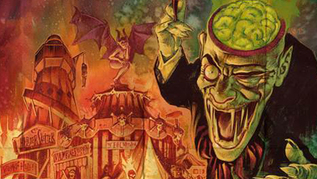
Horror. Wow. The chills just spilled down our next the moment you mentioned it. The blood in the moonlight shining as the spirits dwell on your mind. Suspicious entities wondering around a darkened town and the monsters of our childhood become as real as the mist of breath as you cry for help....help.
What better way to introduce Frightfest 2014 then, a film festival that makes sure you'll never sleep again, by telling you our favourite horror movies!
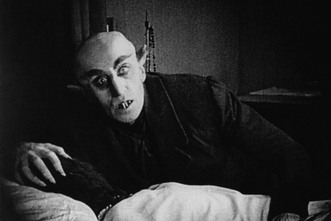
This paragraph is a bit of a lie, because in actuality, The Cabinet of Dr Caligari is my favourite horror film of all time. However, with Caligari getting a re-release at the end of this month, it will shortly receive a shiny new article of its very own. Instead, I choose another classic of the German Expressionist period, Nosferatu.
Ostensibly an adaptation of Dracula, but with the names changed due to copyright restrictions of the time, Nosferatu is a master-class in horror imagery, from the inventive and innovative use of shadow, to the grotesque and horrific figure of Count Orlock. A far cry from the stereotype of the “sexual” vampire that began with Bela Lugosi and prevails to this day, Orlock, as played by Max Schreck, is a towering, hulking, bald beast, with terrifying talons for fingers and an unnerving, unblinking stare. The vision of Orlock’s distinctive shadow ascending the stairs of his victim’s home is a prevailing image, spawning countless parodies and homages throughout the years.
Visuals are key to German Expressionism, and that remains true here. Despite the limited technology of the time, an intricate level of detail is apparent in the composition of shots, the set design, and especially the lighting. Modern horror cinema may be a whirlwind of jump cuts and gore, but Nosferatu manages to be wholly unnerving with pure chiaroscuro and unusual, sometimes mind-boggling shapes. It is a terror that creeps up on you, and lingers long after. A jump cut may scare you for a moment, followed by a release of nervous laughter before it’s forgotten, but the images of Nosferatu stalking through a doorway, his shadow on the stairs, his cold, empty eyes through the window; these are images to keep you up at night.
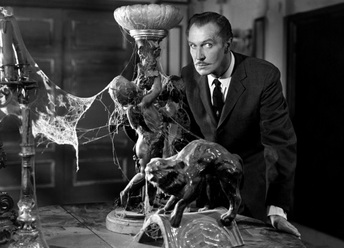
Yes, of course I’m talking about the original. Being such an enormous Vincent Price fan, the remake simply didn’t cut it for me. I quit about half way through. But I’m not here to talk about the constant stream of pointless horror remakes that always miss both the point and the essence of the original (calm down, girl), I’m here to talk about my favourite horror.
It was painful trying to narrow it down; there are so many both classic and contemporary horrors that inspire admiration in me. But personally, it has to be William Castle’s 1959 film, House on Haunted Hill.
Frederick Loren (Vincent Price), the eccentric millionaire with a flair for the dramatic and a passion for the macabre, invites a group of supposed strangers to spend the night in a haunted house – wait for it – on a hill. The ‘haunted party’ is thrown in honour of his fourth wife, with whom his relationship is complicated and bitter.
After a brief reception, Loren appears to tell his guests that he will be locking the doors to the house until morning, and all those who remain living come dawn will be rewarded with $10,000. They all want the money, and tensions inevitably run high – especially as angry spirits begin to reveal themselves.
It sounds cliché, but you have to remember that we’re talking about one of the original haunted house horrors here. When this was made, the cliché didn’t exist. And it the execution is flawless. In an era before CGI and complex prosthetics, the scares rely on the unsaid and the unseen. The tension runs high throughout as you share the uncertainty with the characters – and you will find there is a character with whom everyone can relate.
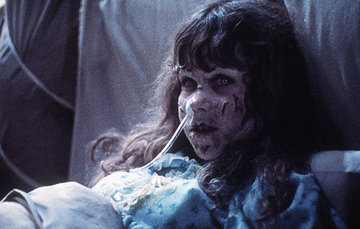
It was controversial, haunting and popular from the moment it opened. William Friedkin’s masterpiece The Exorcist is arguably the definitive horror film of all time. It changed film culture by pushing the boundaries to an extreme. It shocked, it disturbed and got banned in Britain from 1985 to 1998.
The intriguing premise is of an innocent twelve year old girl possessed by a terrifying entity, her mother’s frantic resolve to save her and two priests – one doubt ridden, the other a rock of faith – joined to battle the ultimate evil, left viewers in shock, trauma and torment.
In the early 1970’s films were becoming more daring and experimental to the mainstream public. The controversial A Clockwork Orange and Straw Dogs opened to viewers, reaching world wide acclaim. The Exorcist came on our screens in 1973 and a scandalous horror film was born. Many people collapsed due to the atrocity and psychological horror it delivered. But what was it that drove millions of viewers to put themselves through this bloodcurdling work of art?
Controversy sells and always will. If controversy surrounds a film, the more curious the cat will be. The ‘Exorcist was made on a $12 million dollar budget and grossed over $441 million dollars. It was nominated for ten total Academy Awards in 1973, winning two. It is the first horror film to be nominated for Best Picture. In the end, the film won two statuettes. Best adapted screenplay and best editing.
To this day, it remains a mystery how over the course of shooting, a total of nine cast and crew members of the film died unexpectedly. Coincidence or spiritual inhabitancy will always be an ambiguity, however the fact that film makers were tackling a subject matter that was blasphemous and risky, made us question, was this tackling with the fear of the unknown?
The Exorcist is a must watch horror film as it’s simply the greatest supernatural horror of all time. To this day, it still astonishes and unsettles its viewers like no other movie. If a film creates an impact where you’ll have difficulty sleeping at night; that is what you call a great horror film as it succeeded in its objective. The Exorcist does that and then some.
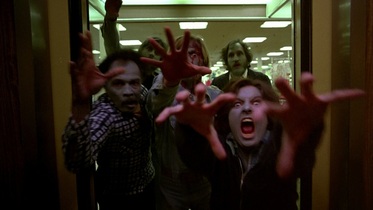
This film used to give me such chills when I was younger, but it was only after rewatching it in my teens when I realised just how powerful a social commentary Dawn of the Dead offered. For George R. Romero it wasn’t enough to pioneer the modern day zombie apocalypse, but to also use it as a platform to explore the darker nature of humanity and how people might go just to live a day longer. Although marketed as a horror film (and those shambling blue corpses sure were terrifying to me as a kid), Dawn of the Dead is – in fact – an illustration of what happens when humans have no one to rely on but themselves.
After the gruesome events of Night of the Living Dead, the whole world’s population falls prey to the same unknown affliction and the Dead begin to reanimate. Society gradually starts to collapse; with the final televised transmissions being sent out during the film’s opening sequence. Dawn of the Dead mainly follows a small group of survivors who seek refuge in a derelict mall during the crises, where they set up shop.
Interpersonal relationships take centre stage and Romero puts heavy focus into developing these characters and fully fleshing them out, illustrating that in such a situation the Dead are only a secondary threat to the still Living. This concept eventually became a motif for zombie movies as a whole, as this film essentially launched the zombie genre as we know it today, Ultimately, a dangerous third party is drawn to the mall and smashes their way in when the group of survivors refuses them access. The hordes of Dead gush in soon after, laying waste to everyone and everything in sight.
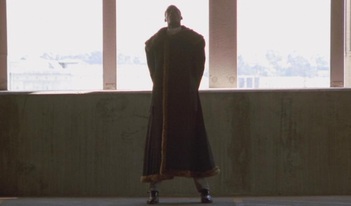
The discovery of horror films when you are a child is a natural part of growing up. When the parents absconded for the night or you were left trembling in your bedrooms, you always had that one friend who would (partly to your dismay) would undo their My Little Pony video case and produce the most mind boggling gore fest you’ve ever witnessed. At least, that’s pretty much how I was introduced to Candyman, though it was more staying up later than you were allowed and discovering what treats Channel 4 had in store for you. In this case, it was Bernard Rose’s unforgettable and triumphant horror movie.
The movie centres on an urban legend that takes prominence in the housing projects of Chicago. Helen Lyle is a student attempting to explore the nature of tales such as these so in order to prove the tale wrong, she utters the name “Candyman” into a mirror five times. However, what transpires (a la horror movie cliché) is that the legend is true.
What doesn’t transpire is an entirely clichéd film. Rose develops this movie in tantalising way that creeps throughout your mind. Setting up a truly atmospheric film, Candyman exudes this mystery, horror and decay. The movie is about tension, set to an unforgettable score by Philip glass, creeps delicately over your skin before shifting into your flesh. It’s less about jumping out and making your heart pound because it’s more about setting that pulsating terror by towering the shadows and chills over you with characters, sympathies and a dark plot. Candyman’s modus operatus is not to just kill Helen but to frame her, breaking her down so she’ll come to him and picking off every one of her loved ones. It’s a glorious twist to the urban legend horrors we are used to. Also Candyman attacks mainly during the day, meaning that the safety of the suns rays is no longer day.
And all this is embodied in our villainous actor Tony Todd Not only his stature as the titular character a frightening paranormal monster, but Todd oozes this Lecter-esque intelligence and charisma. Appearing to Helen halfway through the movie, he leads her down the bloody rabbit hole and ravages all he knows and loves. Todd is captivatingly disturbing here as his voice, in this bellowing beckoning tone, asks Helen to “be his victim.” You can hear him as you sleep…
Just thinking about it i giving me the shivers.
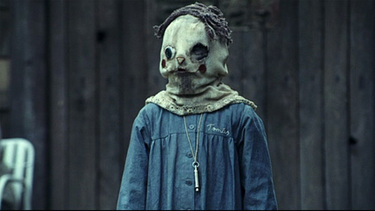
If people talk about foreign-language horror films, they usually just talk about Japanese horror, like The Grudge and The Ring – films which were relatable enough to be remade for modern audiences. But in the last decade, Spanish-language horror has been incredible (mainly thanks to Guillermo del Toro, whether he’s directing, producing or just helping promote younger creative talent).
The Orphanage was produced by del Toro, and it’s really, really difficult to talk about without giving too much away. It looks like your standard horror movie – set in a large, creepy old house, which used to be an orphanage, now bought to be used as a children’s home by one of the former residents. There’s a creaky piece of play equipment out the front (which we only ever see shot from below as it spins in the breeze – spooky). There’s a young child who says his imaginary friends will never grow up, because they can’t. Oh, and a creepy old woman with comedy glasses who ends up stealing a spade in the middle of the night. Of course, there are also ghosts, children who play games with our heroine Laura and her son, Simón. When Simón goes missing, Laura and husband Carlos must decide whether it’s due to kidnapping or supernatural means.
What makes The Orphanage so good is the lack of cheap jump scares. Sometimes it feels like it’s building up to them, with the music slowly increasing the tension during nighttime scenes, but that would be too cheap. Instead, The Orphanage is all about atmosphere and feeling. It’s about a mother’s love for her child, and to what extremes mothers can go to when their child is taken away. And that’s what raises it above the rest. Because while it’s easy for a horror film to scare you, it’s rare to find one that leaves you sobbing with a mixture of happiness and sadness by the end.
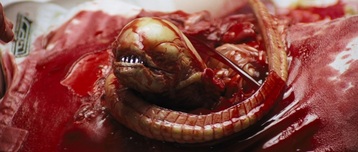
Alien. The daddy, the originator... the movie that spawned a thousand spoofs. Whilst it doesn’t necessarily sit in the exact same genre as the rest of the movies on this list it’s still scary as hell and basically a slasher movie set in space, and that’s why I’m writing about it.
It was a huge success upon with release with people literally queuing round the block to see it at their local cinema. Nobody could have predicted the immense popularity with audiences and critics, especially because of the then-unknown director and lead star; they’re both big names these days, but certainly weren’t in 1979.
Ridley Scott was hired to direct of the back of The Duellists, a relatively decent period drama starring Harvey Keitel that almost nobody has seen. It was his vision for the horrors that take place aboard the doomed Nostromo that have made Alien such an iconic piece of movie history. The long corridors, the flashing lights, the dark corners, the horrific claustrophobia, it all adds up to one scary ass film. This is fear in its most primal form; man being hunted by a creature he can’t even begin to understand.
The alien (or xenomorph) itself is a disgusting, phallic creation from the twisted mind of the late H.R. Giger and the design only adds to the trauma. What is it about a lack of eyes that makes things frightening?
Of course, the real hero of the flick is Sigourney Weaver and her likability as a strong female lead catapulted to her to three more Alien sequels and Hollywood stardom. None of the other three were as good as the original though; it remains a master class in how to direct horror and contains more legendary moment and quotes than I can count.
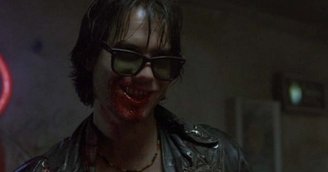
You heard me right, ladies and germs. The last great vampire movie. The inspirer of the inspirers. The Nth degree of infinite vampirism regress. The last time that a vampire was treated like a vampire; as a goddamned monster. No one weeping over losing a soul or having a soul. No question of humanity or religion. Just a touch of a right/wrong dilemma.
For the uninitiated, Near Dark (written & directed by Kathryn Bigelow of Zero Dark Thirty fame) is about a hick called Caleb who encounters a roving pack of vampires (comprising mainly of Bishop, Hudson and Vasquez from Aliens). He gets “turned” and tries in vain to blend in with the homicidal blood-drinking monsters.
The script is great, making Near Dark is eminently quotable (Fun factiod; no one uses the term “vampire”, much like the last great Vampire TV show; Ultraviolet). It’s the Dog Soldiers of Vampire movies. From the “finger lickin’ good”s to the “I fought for the South. We lost”s, you’ll spend the next week trying to, as naturally as possible, work the quotes into conversation.
Indeed, while using Horror tropes (like Dog Soldiers), Near Dark is more Thriller/Action than Horror. While one can debate the movie’s genre (or whether genre is a moot point), it is in the wonderfully flawed characters where the joy truly lies. They are each so wonderful that you want to spend more time with them. It’s almost heart breaking when the monsters start to die.
(Fun factoid; Near Dark was largely overlooked upon release because it came out only two months after the Lost Boys (31st July vs. 2nd October 1987). Joshua Miller, who plays the boy vampire Homer in Near Dark, is the half-brother of Jason Patric, who played Michael in The Lost Boys. Hollywood is indeed a small incestuous town.)
What Do You Think?
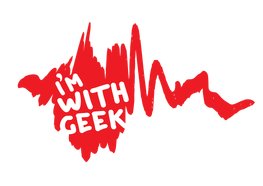
What's your favourite horror movie?
Let us know!

 RSS Feed
RSS Feed
